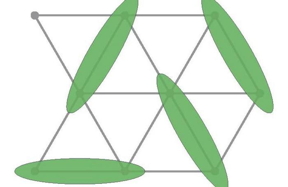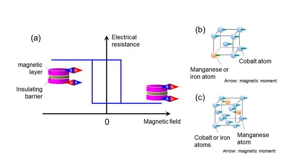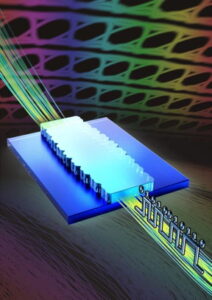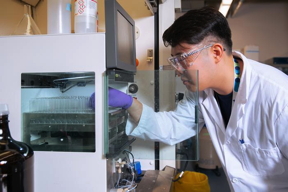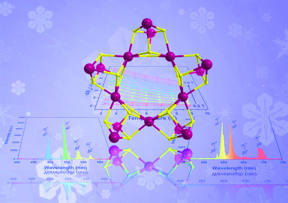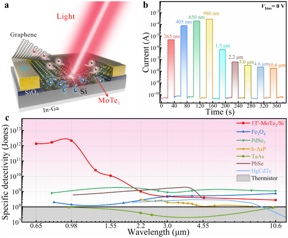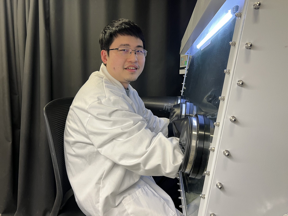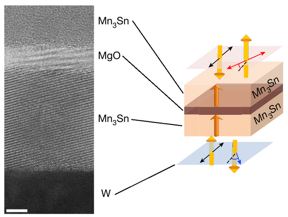Home > Press > Stanford researchers develop a new way to identify bacteria in fluids: An innovative adaptation of the technology in an old inkjet printer plus AI-assisted imaging leads to a faster, cheaper way to spot bacteria in blood, wastewater, and more
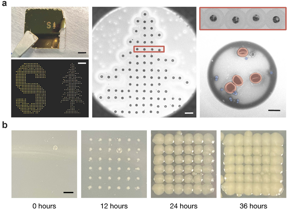 |
| Details of the printed dots on a gold-coated slide (a) where false coloring in the close-up of a single dot shows red blood calls in red and Staphylococcus epidermidis bacteria in blue. The researchers also printed onto an agar-coated slide (b) to show how the dots fare under incubation. CREDIT Fareeha Safir |
Abstract:
Shine a laser on a drop of blood, mucus, or wastewater, and the light reflecting back can be used to positively identify bacteria in the sample.
Stanford researchers develop a new way to identify bacteria in fluids: An innovative adaptation of the technology in an old inkjet printer plus AI-assisted imaging leads to a faster, cheaper way to spot bacteria in blood, wastewater, and more
Stanford, CA | Posted on March 3rd, 2023“We can find out not just that bacteria are present, but specifically which bacteria are in the sample – E. coli, Staphylococcus, Streptococcus, Salmonella, anthrax, and more,” said Jennifer Dionne, an associate professor of materials science and engineering and, by courtesy, of radiology at Stanford University. “Every microbe has its own unique optical fingerprint. It’s like the genetic and proteomic code scribbled in light.”
Dionne is senior author of a new study in the journal Nano Letters detailing an innovative method her team has developed that could lead to faster (almost immediate), inexpensive, and more accurate microbial assays of virtually any fluid one might want to test for microbes.
Traditional culturing methods still in use today can take hours if not days to complete. A tuberculosis culture takes 40 days, Dionne said. The new test can be done in minutes and holds the promise of better and faster diagnoses of infection, improved use of antibiotics, safer foods, enhanced environmental monitoring, and faster drug development, says the team.
Old dogs, new tricks
The breakthrough is not that bacteria display these spectral fingerprints, a fact that has been known for decades, but in how the team has been able to reveal those spectra amid the blinding array of light reflecting from each sample.
“Not only does each type of bacterium demonstrate unique patterns of light but virtually every other molecule or cell in a given sample does too,” said first author Fareeha Safir, a PhD student in Dionne’s lab. “Red blood cells, white blood cells, and other components in the sample are sending back their own signals, making it hard if not impossible to distinguish the microbial patterns from the noise of other cells.”
A milliliter of blood – about the size of a raindrop – can contain billions of cells, only a few of which might be microbes. The team had to find a way to separate and amplify the light reflecting from the bacteria alone. To do that, they ventured along several surprising scientific tangents, combining a four-decade-old technology borrowed from computing – the inkjet printer – and two cutting-edge technologies of our time – nanoparticles and artificial intelligence.
“The key to separating bacterial spectra from other signals is to isolate the cells in extremely small samples. We use the principles of inkjet printing to print thousands of tiny dots of blood instead of interrogating a single large sample,” explained co-author Butrus “Pierre” Khuri-Yakub, a professor emeritus of electrical engineering at Stanford who helped develop the original inkjet printer in the 1980s.
“But you can’t just get an off-the-shelf inkjet printer and add blood or wastewater,” Safir emphasized. To circumvent challenges in handling biological samples, the researchers modified the printer to put samples to paper using acoustic pulses. Each dot of printed blood is then just two trillionths of a liter in volume – more than a billion times smaller than a raindrop. At that scale, the droplets are so small they may hold just a few dozen cells.
In addition, the researchers infused the samples with gold nanorods that attach themselves to bacteria, if present, and act like antennas, drawing the laser light toward the bacteria and amplifying the signal some 1500 times its unenhanced strength. Appropriately isolated and amplified, the bacterial spectra stick out like scientific sore thumbs.
The final piece of the puzzle is the use of machine learning to compare the several spectra reflecting from each printed dot of fluid to spot the telltale signatures of any bacteria in the sample.
“It’s an innovative solution with the potential for life-saving impact. We are now excited for commercialization opportunities that can help redefine the standard of bacterial detection and single-cell characterization,” said senior co-author Amr Saleh, a former postdoctoral scholar in Dionne’s lab and now a professor at Cairo University.
Catalyst for collaboration
This sort of cross-disciplinary collaboration is a hallmark of the Stanford tradition in which experts from seemingly disparate fields bring their varying expertise to bear to solve longstanding challenges with societal impact.
This particular approach was hatched during a lunchtime meeting at a café on campus and, in 2017, was among the first recipients of a series of $3 million grants distributed by Stanford’s Catalyst for Collaborative Solutions. Catalyst grants are specifically targeted at inspiring interdisciplinary risk-taking and collaboration among Stanford researchers in high-reward fields such as health care, the environment, autonomy, and security.
While this technique was created and perfected using samples of blood, Dionne is equally confident that it can be applied to other sorts of fluids and target cells beyond bacteria, like testing drinking water for purity or perhaps spotting viruses faster, more accurately, and at lower cost than present methods.
Additional Stanford co-authors include former PhD student Loza Tadesse; research staff Kamyar Firouzi; Niaz Banaei, professor of pathology and of medicine at the School of Medicine; and Stefanie Jeffrey, the John and Marva Warnock Professor, Emerita, in the School of Medicine. Nhat Vu from Pumpkinseed Technologies is also a co-author. Banaei, Dionne, Jeffrey, and Khuri-Yakub are also members of Stanford Bio-X. Dionne is also senior associate vice provost of research platforms/shared facilities, a member of the Cardiovascular Institute and the Wu Tsai Neurosciences Institute, and an affiliate of the Precourt Institute for Energy. Jeffrey is also a member of the Stanford Cancer Institute. Khuri-Yakub is also a member of the Cardiovascular Institute, the Stanford Cancer Institute, and the Wu Tsai Neurosciences Institute.
This research was funded by the Stanford Catalyst for Collaborative Solutions, the Chan Zuckerberg Biohub Investigator Program, the NIH-NCATS-CTSA, the Gates Foundation, the National Science Foundation, the NIH New Innovator Award, and from seed funds from the Stanford Center for Innovation in Global Health. Part of this work was performed at the Stanford Nano Shared Facilities (SNSF) and the Soft & Hybrid Materials Facility (SMF), which are supported by the National Science Foundation and National Nanotechnology Coordinated Infrastructure.
####
For more information, please click here
Contacts:
Jill Wu
Stanford University School of Engineering
Copyright © Stanford University School of Engineering
If you have a comment, please Contact us.Issuers of news releases, not 7th Wave, Inc. or Nanotechnology Now, are solely responsible for the accuracy of the content.
| Related Links |
| Related News Press |
News and information
![]() Scientists push the boundaries of manipulating light at the submicroscopic level March 3rd, 2023
Scientists push the boundaries of manipulating light at the submicroscopic level March 3rd, 2023
![]() Lipid nanoparticles highly effective in gene therapy March 3rd, 2023
Lipid nanoparticles highly effective in gene therapy March 3rd, 2023
Govt.-Legislation/Regulation/Funding/Policy
![]() Novel microscope developed to design better high-performance batteries: Innovation gives researchers inside view of how batteries work February 10th, 2023
Novel microscope developed to design better high-performance batteries: Innovation gives researchers inside view of how batteries work February 10th, 2023
![]() Make them thin enough, and antiferroelectric materials become ferroelectric February 10th, 2023
Make them thin enough, and antiferroelectric materials become ferroelectric February 10th, 2023
Possible Futures
![]() Scientists develop self-tunable electro-mechano responsive elastomers March 3rd, 2023
Scientists develop self-tunable electro-mechano responsive elastomers March 3rd, 2023
![]() Recent progress of carbon-based non-noble metal single-atom catalysts for energy conversion electrocatalysis March 3rd, 2023
Recent progress of carbon-based non-noble metal single-atom catalysts for energy conversion electrocatalysis March 3rd, 2023
Nanomedicine
![]() Getting drugs across the blood-brain barrier using nanoparticles March 3rd, 2023
Getting drugs across the blood-brain barrier using nanoparticles March 3rd, 2023
![]() Scientists push the boundaries of manipulating light at the submicroscopic level March 3rd, 2023
Scientists push the boundaries of manipulating light at the submicroscopic level March 3rd, 2023
![]() Lipid nanoparticles highly effective in gene therapy March 3rd, 2023
Lipid nanoparticles highly effective in gene therapy March 3rd, 2023
Discoveries
![]() Scientists develop self-tunable electro-mechano responsive elastomers March 3rd, 2023
Scientists develop self-tunable electro-mechano responsive elastomers March 3rd, 2023
![]() Recent progress of carbon-based non-noble metal single-atom catalysts for energy conversion electrocatalysis March 3rd, 2023
Recent progress of carbon-based non-noble metal single-atom catalysts for energy conversion electrocatalysis March 3rd, 2023
![]() Getting drugs across the blood-brain barrier using nanoparticles March 3rd, 2023
Getting drugs across the blood-brain barrier using nanoparticles March 3rd, 2023
Announcements
![]() Recent progress of carbon-based non-noble metal single-atom catalysts for energy conversion electrocatalysis March 3rd, 2023
Recent progress of carbon-based non-noble metal single-atom catalysts for energy conversion electrocatalysis March 3rd, 2023
![]() Getting drugs across the blood-brain barrier using nanoparticles March 3rd, 2023
Getting drugs across the blood-brain barrier using nanoparticles March 3rd, 2023
![]() Scientists push the boundaries of manipulating light at the submicroscopic level March 3rd, 2023
Scientists push the boundaries of manipulating light at the submicroscopic level March 3rd, 2023
Interviews/Book Reviews/Essays/Reports/Podcasts/Journals/White papers/Posters
![]() Recent progress of carbon-based non-noble metal single-atom catalysts for energy conversion electrocatalysis March 3rd, 2023
Recent progress of carbon-based non-noble metal single-atom catalysts for energy conversion electrocatalysis March 3rd, 2023
![]() Getting drugs across the blood-brain barrier using nanoparticles March 3rd, 2023
Getting drugs across the blood-brain barrier using nanoparticles March 3rd, 2023
![]() Scientists push the boundaries of manipulating light at the submicroscopic level March 3rd, 2023
Scientists push the boundaries of manipulating light at the submicroscopic level March 3rd, 2023
Artificial Intelligence
![]() 3D-printed decoder, AI-enabled image compression could enable higher-res displays December 9th, 2022
3D-printed decoder, AI-enabled image compression could enable higher-res displays December 9th, 2022
![]() New chip ramps up AI computing efficiency August 19th, 2022
New chip ramps up AI computing efficiency August 19th, 2022
![]() Artificial Intelligence Centered Cancer Nanomedicine: Diagnostics, Therapeutics and Bioethics June 3rd, 2022
Artificial Intelligence Centered Cancer Nanomedicine: Diagnostics, Therapeutics and Bioethics June 3rd, 2022
![]() ‘Nanomagnetic’ computing can provide low-energy AI, researchers show May 6th, 2022
‘Nanomagnetic’ computing can provide low-energy AI, researchers show May 6th, 2022
Grants/Sponsored Research/Awards/Scholarships/Gifts/Contests/Honors/Records
![]() UC Irvine researchers decipher atomic-scale imperfections in lithium-ion batteries: Team used super high-resolution microscopy enhanced by deep machine learning January 27th, 2023
UC Irvine researchers decipher atomic-scale imperfections in lithium-ion batteries: Team used super high-resolution microscopy enhanced by deep machine learning January 27th, 2023
![]() Polymer p-doping improves perovskite solar cell stability January 20th, 2023
Polymer p-doping improves perovskite solar cell stability January 20th, 2023
Nanobiotechnology
![]() Getting drugs across the blood-brain barrier using nanoparticles March 3rd, 2023
Getting drugs across the blood-brain barrier using nanoparticles March 3rd, 2023
![]() Scientists push the boundaries of manipulating light at the submicroscopic level March 3rd, 2023
Scientists push the boundaries of manipulating light at the submicroscopic level March 3rd, 2023
![]() Lipid nanoparticles highly effective in gene therapy March 3rd, 2023
Lipid nanoparticles highly effective in gene therapy March 3rd, 2023
Photonics/Optics/Lasers
![]() Photonic Materials: Recent Advances and Emerging Applications February 10th, 2023
Photonic Materials: Recent Advances and Emerging Applications February 10th, 2023
![]() New study opens the door to ultrafast 2D devices that use nonequilibrium exciton superdiffusion February 10th, 2023
New study opens the door to ultrafast 2D devices that use nonequilibrium exciton superdiffusion February 10th, 2023
![]() Researchers demonstrate co-propagation of quantum and classical signals: Study shows that quantum encryption can be implemented in existing fiber networks January 20th, 2023
Researchers demonstrate co-propagation of quantum and classical signals: Study shows that quantum encryption can be implemented in existing fiber networks January 20th, 2023
- SEO Powered Content & PR Distribution. Get Amplified Today.
- Platoblockchain. Web3 Metaverse Intelligence. Knowledge Amplified. Access Here.
- Source: http://www.nanotech-now.com/news.cgi?story_id=57310
- :is
- $3
- $UP
- 10
- 2017
- 27th
- 2D
- a
- Able
- About
- accuracy
- accurate
- accurately
- across
- Act
- adaptation
- addition
- advances
- Affiliate
- AI
- alone
- Amid
- among
- amplifying
- and
- Antibiotics
- applied
- approach
- appropriately
- architecture
- ARE
- Array
- artificial
- artificial intelligence
- AS
- Associate
- At
- attach
- AUGUST
- author
- award
- back
- Bacteria
- Bandwidth
- barrier
- batteries
- BE
- Bear
- become
- Better
- Beyond
- Billion
- billions
- blood
- Blue
- boost
- borrowed
- boston
- boundaries
- Brain
- breakthrough
- bring
- broad
- by
- CA
- Calls
- camera
- Campus
- CAN
- Cancer
- candidate
- carbon
- care
- Catalyst
- catalysts
- cell phones
- Cells
- Center
- centered
- CGI
- challenges
- cheaper
- chip
- click
- Co-Author
- code
- collaboration
- collaborative
- COM
- combining
- comment
- commercialization
- compare
- complete
- components
- computing
- confident
- Connect
- consumer
- content
- control
- Conversion
- coordinated
- CORPORATION
- Cost
- could
- created
- credit
- Culture
- cutting-edge
- Cutting-Edge Technologies
- Days
- decades
- December
- Decipher
- deep
- demonstrate
- demonstrated
- Design
- Detailing
- details
- Detection
- develop
- developed
- developing
- Development
- develops
- Devices
- Diego
- disparate
- Display
- distinguish
- distributed
- Dogs
- Door
- DOT
- dozen
- drawing
- Drop
- drug
- drug development
- Drugs
- during
- e
- E. coli
- each
- Effective
- electrical engineering
- Electronic
- Electronics
- emerging
- emission
- emphasized
- enable
- encryption
- energy
- Engineering
- Engineers
- enhanced
- enough
- Environment
- environmental
- equally
- Ether (ETH)
- Every
- excited
- existing
- expertise
- experts
- explained
- extremely
- facilities
- Facility
- fast-charging
- faster
- February
- few
- Fields
- films
- final
- Find
- fingerprint
- First
- flexible
- flow
- foods
- For
- Former
- Foundation
- Frequency
- from
- fund
- funded
- funds
- future
- Gates
- get
- gif
- given
- gives
- Global
- Global health
- Gold
- grants
- Growing
- Handling
- Hard
- Have
- Health
- Health Care
- help
- helped
- high-performance
- high-resolution
- highly
- hold
- holds
- HOURS
- How
- http
- HTTPS
- Hybrid
- identify
- image
- Imaging
- immediate
- Impact
- implemented
- impossible
- improved
- improves
- in
- Inc.
- include
- Including
- INCUBATION
- inexpensive
- infection
- information
- Infrastructure
- infused
- Innovation
- innovative
- Innovator
- inspiring
- instead
- Institute
- Intelligence
- International
- isolated
- IT
- ITS
- January
- Jennifer
- John
- journal
- Key
- known
- lab
- large
- large-scale
- laser
- lead
- Leads
- learning
- light
- like
- links
- lithium
- machine
- machine learning
- Making
- manipulating
- March
- material
- materials
- medicine
- meeting
- member
- Members
- metal
- method
- methods
- Microscope
- Microscopy
- might
- million
- minutes
- modified
- molecule
- monitoring
- more
- mucus
- multinational
- nano
- Nanomedicine
- nanotechnology
- National
- National Science
- net
- neurotransmitter
- New
- news
- night
- NIH
- Noise
- of
- Old
- on
- ONE
- open
- opens
- opportunities
- Origin
- original
- Other
- outreach
- own
- Paper
- part
- particular
- pathology
- patterns
- perhaps
- phones
- PHP
- piece
- plastic
- plato
- Plato Data Intelligence
- PlatoData
- please
- plus
- polymer
- Post
- posted
- potential
- present
- principles
- Professor
- Program
- Progress
- promise
- propose
- proposed
- provide
- Push
- put
- puzzle
- Quantum
- quantum computing
- radiology
- Ramps
- receives
- recent
- recipients
- Red
- reducing
- Releases
- research
- researcher
- researchers
- responsible
- responsive
- return
- reveal
- safer
- Said
- Samsung
- San
- San Diego
- Save
- says
- Scale
- School
- Science
- Search
- security
- seed
- sending
- senior
- sense
- sensors
- separate
- separating
- Series
- several
- Share
- shared
- show
- Shows
- Signal
- signals
- Signatures
- Simple
- single
- Size
- Slide
- small
- smaller
- So
- societal
- Soft
- solar
- solution
- Solutions
- SOLVE
- some
- specifically
- Spectral
- Spot
- Staff
- standard
- stanford
- Stanford university
- start
- Step
- Stick
- Still
- storage
- strength
- Student
- Study
- submit
- such
- suitable
- Super
- Superconductivity
- Supported
- Surface
- surprising
- system
- Take
- takes
- Target
- targeted
- team
- Technologies
- Technology
- test
- Testing
- that
- The
- their
- Them
- themselves
- therapeutics
- thermal
- These
- thousands
- time
- times
- to
- today
- too
- toward
- tradition
- transitions
- under
- understand
- unique
- university
- us
- use
- View
- virtually
- viruses
- vision
- volume
- Water
- Wave
- Way..
- which
- while
- white
- WHO
- will
- with
- Work
- wu
- Yahoo
- zephyrnet
- Zuckerberg










